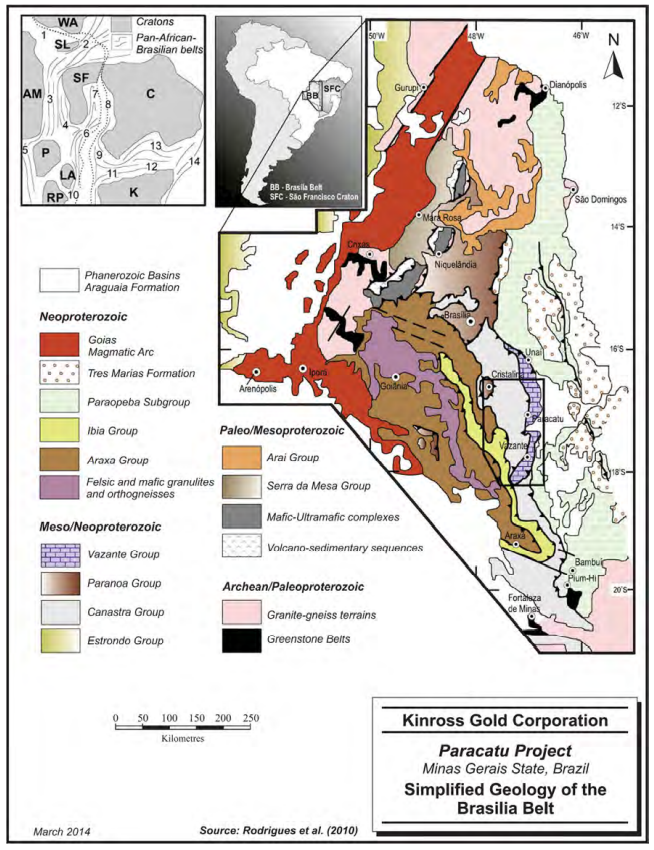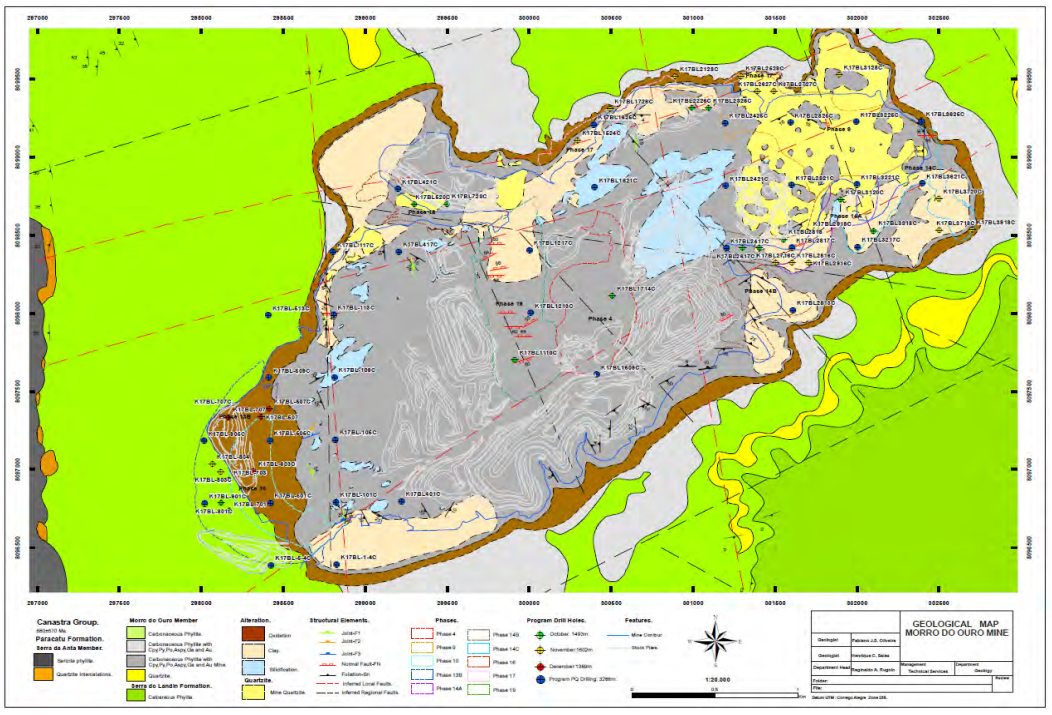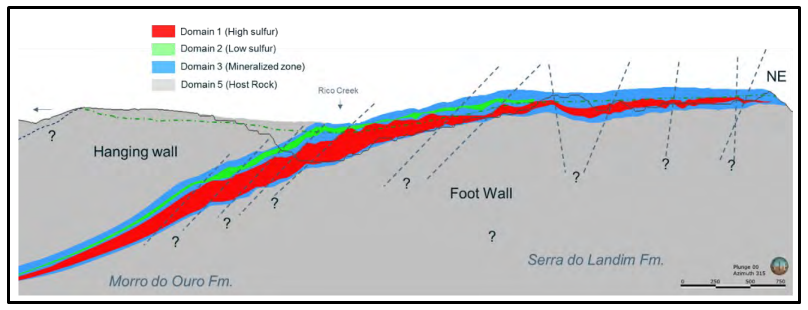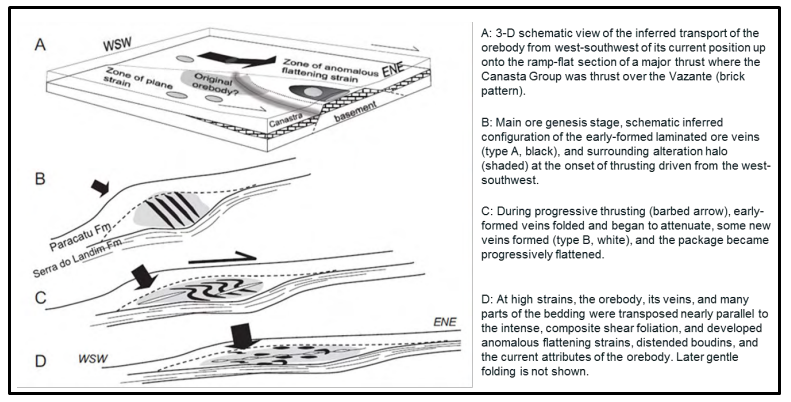The Paracatu Mine, also referred to as the Morro do Ouro Mine, is located immediately north of the city of Paracatu and 230 km southeast of the national capital of Brasilia in northwestern Minas Gerais State, Brazil. The Project comprises an open pit mine as well as processing plants, tailings facilities and associated infrastructure. The mine commenced production in 1987 and currently processes ore at a nominal plant throughput rate of 61 Mt/a.
History
The mining history of the Paracatu region is closely associated with the activities of the Portuguese bandeirantes who prospected for gold in Brazil’s interior, arriving in the Paracatu region in 1722 after the discovery of gold in alluvial deposits.
Alluvial mining peaked during the second half of the 18th century. These activities were not limited to the placer deposits along Rico Creek, but also extended to the oxidized ore outcrop on the top of Morro do Ouro or the “Hill of Gold”.
Gold production declined sharply during the first decade of the 19th century. From this point forward, production was limited to subsistence mining practiced by local inhabitants known as garimpeiros. Various prospectors explored the region but economically viable operations were limited as a result of the low-grade nature of the deposits.
Beginning in 1970, Paracatu attracted some attention from mineral exploration companies looking for lead and zinc deposits in the area. Interest in the gold of Morro do Ouro was limited as the majority of the companies were not attracted by low grades that were initially considered to be too low to be extracted economically.
In 1984, Riofinex embarked on a surface exploration program that focused on the oxidized and weathered horizons of the Morro do Ouro area.
A 1984 “reserve” estimate only included the near surface oxidized ore. Despite the low gold grade, Riofinex believed that profitable extraction of the ore could be realized. In 1985, this was confirmed by a feasibility study. Total investment up to that period was $7.3 million including ground acquisition costs, exploration costs, and the cost of the feasibility study. Approval was granted by Rio Tinto to construct a mining project at a capital cost of approximately $65 million.
Production at Paracatu commenced in October 1987, treating oxidized and highly weathered ore. The first gold bar was poured in December 1987.
Regional Geology
The Paracatu Property is hosted within the Brasília Belt, a north-south trending Neoproterozoic belt that extends along the western side of the São Francisco-Congo Craton.
The Brasilia Belt resulted from the collision between three cratonic blocks: the Amazonian, the São Francisco-Congo and a third block concealed under Phanerozoic sediments of the Parana Basin. Sedimentary units are mostly preserved in the northern part of the belt, whereas in the southern part where Paracatu is located, there is intense deformation and metamorphism, and contacts between metasedimentary units are primarily tectonic (Rodrigues et al., 2010).
The Brasília Belt has four main components (Rodrigues et al., 2010 and references therein):
- A continental block of Archaean rock units (the Crixás-Goiás region).
- Reworked sialic basement of Paleoproterozoic age, exposed mainly in the Almas-Cavalcante region.
- The Goiás Magmatic Arc, consisting of volcano-sedimentary rocks and tonalite/granodiorite gneisses.
- Thick sedimentary and metasedimentary sequences, including coarse and fine grained sediments with some carbonates, volcanic layers, phyllites, quartzites, and schists.
A series of east-northeast trending thrust faults is developed extensively along the belt. Metamorphic grade increases towards the west as the thickness of the fold belt increases. The timing of deformation is estimated at 800 Ma to 600 Ma during the Brasiliano orogenic cycle.
Simplified geology of the Brasilia Belt.
Local Geology
The local scale geology is composed of sandy and shaley metasedimentary rocks, metamorphosed to greenschist grade, of the Canastra Group. , The stratigraphy is not fully understood because of intense deformation. The Project is underlain by a thick sequence of phyllites belonging to the basal part of the Paracatu Formation of the Upper Proterozoic Canastra Group, which is exposed along the south-central portion of the Brasília Belt.
Around Paracatu, the Canastra Group is subdivided into three formations: at the base is Serra do Landim Formation, overlain by the Paracatu Formation, followed by the Chapada dos Piloes Formation.
Local geology
The Canastra Group is made up of the following lithostratigraphic units, from base to top, which are separated from each other by thrust faults (Rodrigues et al., 2010).
Serra do Landim Formation
This unit mainly consists of calciferous shales and schists, with marble and limestone lenses.
Paracatu Formation
The Paracatu Formation includes the basal Morro do Ouro Member, a 100 m thick layer of dark carbonaceous phyllite, and the overlying Serra da Anta Member, a sericitic phyllite. Both phyllites display fine-grained quartzite intercalations.
Chapada dos Pilões Formation
This unit includes the basal Serra da Urucânia Member, a succession of quartzite and phyllite, and the upper Hidroelétrica Batalha Member, consisting of fine-grained quartzite and thinly-bedded phyllite.
Stratigraphic column, Morro do Ouro member region.
Property Geology
In the property area, the rocks are phyllites and quartzite intensively altered by hydrothermal processes associated with regional metamorphism.
The property geology has extensive deformation and well-developed quartz boudins and associated sulfide mineralization. Sericite minerals are common, likely as a result of extensive metamorphic alteration of the host rocks. Primary sedimentary features and bedding planes are recognizable, but are intensely deformed by sigmoidal and boudinage structures, and by thrusting, particularly along bedding planes.
Mineralization at Paracatu is closely related to a period of ductile deformation, shearing and thrust faulting. Overall, the Morro do Ouro sequence has been thrust to the northeast. Intense, low angle isoclinal folds are commonly observed. The mineralization plunges to the west southwest at 15° to 20° and there is secondary folding with axial planes striking to the northwest resulting in kink bands, and dome and basin folds in some areas.
The mineralization appears to be truncated to the north by a major normal fault trending east-northeast. The displacement along this fault is currently unknown but the fault is used as a hard boundary during mineral resource estimation. The current interpretation is that the fault has displaced the mineralization upwards and erosion has removed the mineralization in the up-thrown block.
Property geology of the Paracatu deposit.
Cross section of the Paracatu deposit (vertical exaggeration 2x).
Mineralization
The entire mineralized system lies within a thick, heterogeneously deformed zone that contains both abundant NE vergent shallowly dipping shear fabrics and a strong planar or tabular (flattened) strain signature.
The Paracatu mineralization has two characteristic visual features. The first is the presence of a sulfide suite intimately associated with gold, comprising, in order of abundance, arsenopyrite, pyrite, pyrrhotite, sphalerite, galena, and chalcopyrite.
The sulfides occur in a variety of forms, predominantly within boudinaged quartz veins or on their edges, and in the necks of the boudins. Some sulfides (pyrite, arsenopyrite, and pyrrhotite, very rare chalcopyrite and sphalerite, no galena) are also present in the host shales as veinlets and disseminations, usually in the cm- to m-scale in the vicinity of the sulfide-bearing quartz veins. (Oliver et al., 2015).
The second characteristic feature of Paracatu mineralization is the occurrence of boudinaged quartz ± carbonate ± sulfide veins.
Boudins make up, on average, 8% to 10% by volume of the mineralized rock, though there are wide variations. The central part of the orebody may contain >20% boudin material, but at the margins volumes drop off to 1% to 2% or less. Boudins and their immediate host rocks contain >90% of the sulfides and gold, based on comparison of bulk ore analyses, boudin analyses, and spatial analysis of boudin/vein distribution.
Deformation has produced distinctly separated boudins, distributed along linear trains at a low angle to the bedding of the host stratigraphy. These structures were affected by predominantly oblate flattening strains, producing “chocolate-tablet” boudinage, with less common examples of simple log-like boudins expected from a plane strain deformation (Oliver et al., 2015).
Gold occurs either as free gold or electrum. Microscopic analysis indicates that 92% of the gold at Paracatu is free-milling with less than 8% encapsulated by sulfide grains or silica.
Deposit types
The Morro do Ouro is a metamorphic gold system with finely disseminated gold mineralization hosted within metasedimentary rocks.
Gold mineralization was introduced syn-tectonically as the result of metamorphic alteration during thrusting of the Morro do Ouro Sequence over the rocks of the younger Vazante Formation. Structural interpretation suggests that mineralization was precipitated within a high strain zone where silica and carbonate were depleted from host phyllites, resulting in an increase in graphite content that may have acted as a chemical trap, precipitating out gold and sulfide mineralization remobilized during the metamorphic alteration of the Morro do Ouro Sequence.
The deposit has extraordinary lateral and longitudinal continuity. The majority of exploration efforts have sought to better define the continuous longitudinal continuity of mineralized phyllites at depth west of Rico Creek and the lateral limits of the economic mineralization.
Schematic diagrams illustrating the proposed mechanism of formation of the Morro do Ouro deposit (Oliver et al., 2015).
Mineral Resource & Reserve Estimate
Mineral Resources have an effective date of December 31, 2019.
Mineral Resources are reported using a gold price of $1,400/oz and variable cut-off grades based on BWI and global recovery. Processing recoveries and associated operating conditions were used to generate an optimized pit shell. Mineral Resources are exclusive of Mineral Reserves and are reported between the EOY 2019 projected topography and ultimate pit design.
Inferred Mineral Resources include an estimated 367 koz of gold contained (47,159 kt with 0.2 g/t) in the Santo Antônio tailings deposit (PSAT). The remaining 1 koz (107 kt with 0.3 g/t) of Inferred is in situ material in the resource pit shell.
Mineral Resources are reported at gold cut-off grade that varies by BWI and global recovery from 0.11 g/t to 0.19 g/t.
Mineral Reserves estimated according to CIM Definitions.
Mineral Reserves estimated at $1,200/oz Au.
Stockpile balances above the reserve cut-off grade is considered as reserve and it includes estimated PSAT gold production in 2020.
Mineral Reserves are reported at gold cut-off grade that varies by BWI and global recovery from 0.16 g/t to 0.24 g/t.
Mineral Resources & Reserve Summary Table
Paracatu gold deposit on the map.
Source: NI 43-101 Technical Report
Prepared by: John Sims, AIPG Certified Professional Geologist
Effective Date: March 10, 2020






